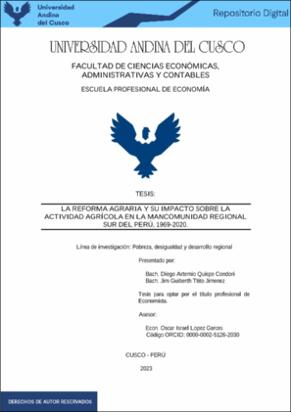| dc.contributor.advisor | López Garcés, Oscar Israel | |
| dc.contributor.author | Quispe Condori, Diego Artemio | |
| dc.contributor.author | Ttito Jimenez, Jim Guiberth | |
| dc.date.accessioned | 2023-12-01T19:41:50Z | |
| dc.date.available | 2023-12-01T19:41:50Z | |
| dc.date.issued | 2023-08-31 | |
| dc.identifier.uri | https://hdl.handle.net/20.500.12557/5889 | |
| dc.description.abstract | La reforma agraria en Perú fue la política más importante del siglo XX para la redistribución
de tierras, con potencial para mitigar el malestar rural y transformar el sector agrícola
peruano. Bajo este contexto, la presente investigación tiene como objetivo establecer el
impacto de la Reforma Agraria sobre la actividad agrícola en la Mancomunidad Regional
Sur del Perú durante el período 1969-2020, y analizar los mecanismos que explican esta
relación: (1) La organización social, (2) La Productividad Agrícola y (3) Lucha contra el
terrorismo en zonas agrícolas. La investigación utiliza información del Sistema Integrado de
Estadísticas Agrarias (SIEA) del MIDAGRI, junto con la ubicación geográfica de las zonas
de reforma agraria e información de la Comisión de Verdad y Reconciliación. El estudio
utiliza un modelo de regresión discontinua aprovechando el cambio discontinuo en la
intensidad de la reforma para los distritos dentro de una zona agraria en un departamento
central, donde se ubicaba la oficina regional de reforma agraria. Los resultados sugieren que
la Reforma Agraria no tuvo un impacto significativo en la actividad agrícola de la
Mancomunidad Regional Sur del Perú, con efectos nulos en el porcentaje de superficie
agrícola, el porcentaje de superficie con registros públicos, el porcentaje de productos
financiados y el porcentaje de superficie con riesgo, así como en el valor de la producción
agrícola. Asimismo, se ha encontrado que la reforma agraria redujo el conflicto por
terrorismo en zonas agrarias. | es_PE |
| dc.description.abstract | The agrarian reform in Peru was the most important policy of the 20th century for land
redistribution, with the potential to mitigate rural unrest and transform the Peruvian
agricultural sector. In this context, this research aims to establish the impact of the Agrarian
Reform on agricultural activity in the Southern Regional Commonwealth of Peru during the
period 1969-2020 and analyze the mechanisms that explain this relationship: (1) Social
organization, (2) Agricultural Productivity and (3) Fight against terrorism in agricultural
areas. The research uses information from the Integrated System of Agrarian Statistics
(SIEA) of MIDAGRI, together with the geographic location of the agrarian reform zones
and information from the Truth and Reconciliation Commission. The study employs a
regression discontinuity design taking advantage of the discontinuous change in reform
intensity for districts within an agrarian zone in a central department, where the regional
agrarian reform office was located. The results suggest that the Agrarian Reform did not
have a significant impact on the agricultural activity of the Southern Regional
Commonwealth of Peru, with null effects on the percentage of agricultural land, the
percentage of land with public records, the percentage of financed products and the
percentage of area at risk, as well as in the value of agricultural production. Likewise, it has
been found that the agrarian reform reduced the conflict due to terrorism in agrarian areas. | en_US |
| dc.format | application/pdf | es_PE |
| dc.language.iso | spa | es_PE |
| dc.publisher | Universidad Andina del Cusco | es_PE |
| dc.rights | info:eu-repo/semantics/openAccess | es_PE |
| dc.rights.uri | https://creativecommons.org/licenses/by-nc-nd/4.0/ | es_PE |
| dc.subject | Reforma agraria | es_PE |
| dc.subject | Regresión discontinua | es_PE |
| dc.subject | Productividad agrícola | es_PE |
| dc.title | La reforma agraria y su impacto sobre la actividad agrícola en la mancomunidad regional sur del Perú, 1969-2020. | es_PE |
| dc.type | info:eu-repo/semantics/bachelorThesis | es_PE |
| thesis.degree.name | Economista | es_PE |
| thesis.degree.grantor | Universidad Andina del Cusco. Facultad de Ciencias Económicas, Administrativas y Contables | es_PE |
| thesis.degree.discipline | Economía | es_PE |
| dc.publisher.country | PE | es_PE |
| dc.subject.ocde | https://purl.org/pe-repo/ocde/ford#5.02.01 | es_PE |
| renati.advisor.dni | 40044110 | |
| renati.advisor.orcid | https://orcid.org/0000-0002-5126-2030 | es_PE |
| renati.author.dni | 72897769 | |
| renati.author.dni | 46803703 | |
| renati.discipline | 311016 | es_PE |
| renati.juror | Paredes Gordón, Tito Livio | |
| renati.juror | Miranda Acuña, Margarita | |
| renati.juror | Del Castillo Bejar, Maria Lourdes | |
| renati.juror | Vargas Gibaja, Aurelio | |
| renati.level | https://purl.org/pe-repo/renati/level#tituloProfesional | es_PE |
| renati.type | https://purl.org/pe-repo/renati/type#tesis | es_PE |
| dc.description.lineadeinvestigacion | Pobreza, desigualdad y desarrollo regional | es_PE |




